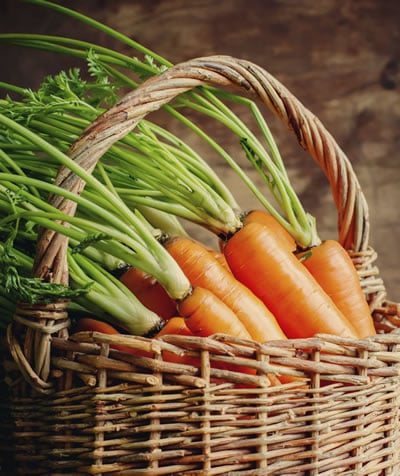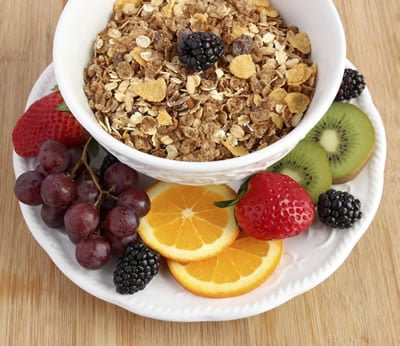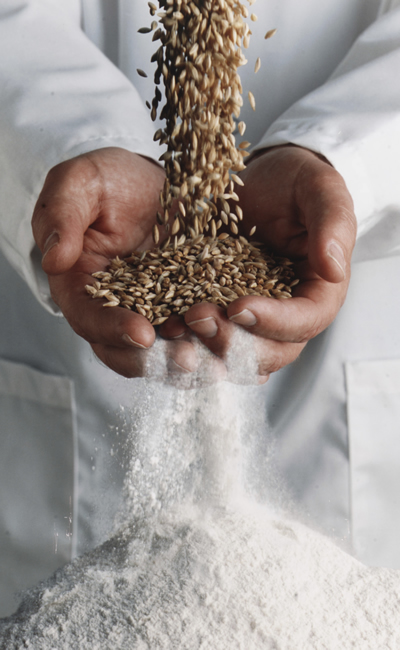Good Carbs vs Bad Carbs – What Are You Eating?
Poor carbs. They’re still getting bashed. There’s still confusion – sometimes even fear – about a carbohydrate-rich diet. So in this article, we’ll try to clear up the confusion quickly and simply.

Good Carbs vs Bad Carbs
Some carbs truly are bad. And some carbs are tremendously good for you. How do you know the difference?
That’s where the confusion comes in. Some doctors talk about the glycemic index. Others blame insulin surges. Some rail against individual ingredients like high fructose corn syrup. And others want to know about your metabolic rate. Getting bleary-eyed? Why wouldn’t you – and for that matter, everyone else?
What’s heartening to know is that the whole mess really can be boiled down to two basic rules…
- Fill your daily diet with real food, that is, carbohydrates that look as if they actually came out of the earth. Eat whole corn kernels, for example, instead of corn flakes. Reach for a whole orange instead of orange “vitamin water,” or even orange juice. Choose brown rice, not white rice. The less processed and refined a carb is, the healthier – and better for your waistline – it tends to be.
- Steer clear of fake carbs. By fake, we mean food that is more a product of factories than of the soil. Fake carbs are foods that have been so overly processed – fiber stripped, nutrients stripped, water squeezed out, fat added, salt added, sugar added, calories added – that they are something “our great-great grandmothers would not have recognized as food,” writes Michael Pollan in his excellent book In Defense of Food.
Your Great-Great Grandmother Knew Better
Your great-great grandmother would know potatoes. She’d be wary (and we should be, too) of potato chips, not to mention French fries with chili cheese sauce. She’d recognize fresh strawberries and oats, not strawberry flavored breakfast cereal. She’d know whole-grain bread, not bagel snack chips.
If she were from Italy, she’d know fresh tomatoes, garlic, and herbs, not canned tomato sauce.
What, more specifically, are real, or good, carbs? They’re fresh fruits; fresh vegetables; whole grains like oats, barley, whole-grain couscous, brown rice, quinoa, millet, and sprouted whole-grain bread; starchy vegetables like potatoes, corn, and yams; and legumes like black beans, peas, and pinto beans.
Does the above look like our Western diet? Not even close! The main features of the Western diet are lots of meat; full-fat dairy foods like butter and cheese; and processed, super-calorie-dense carbs full of fat, salt, and/or sugar, such as donuts, corn chips, white-flour bread, macaroni and cheese, pretzels and cereal bars.
In short, the Western diet has lots of everything except fruits, vegetables, legumes, and whole grains.
Good Carbs vs Bad Carbs
Why are good carbs like fruits, vegetables, legumes, and whole grains (especially cooked whole grains) so good for us? Let us count just some of the many ways.
Good carbs are:
- Low to moderate in calorie density, which means we can eat filling amounts and satisfy our hunger, but not worry about going overboard on calories.
- High in an enormous variety of nutrients.
- Devoid of refined sugars and refined grains. In America, refined sugars like corn syrup now make up more than 20% of the calories we eat each day. That’s a big problem because our human bodies evolved over centuries and centuries to metabolize unrefined carbohydrates. We’re equipped to handle corn. We’re clueless about high fructose corn syrup. Daily tsunamis of sugar in our bloodstream are directly linked to our current epidemics of obesity and type 2 diabetes.
- High in naturally occurring fiber, which helps lower not only blood sugar and insulin levels but also LDL bad cholesterol. Fiber-rich foods also help you fill up on fewer calories so that you can lose weight more easily. A high-fiber diet also helps prevent constipation, hemorrhoids, and certain cancers. Americans average just 12 to 15 grams of fiber a day. Nutrition experts say we ought to be getting at least 35 to 50 fiber grams daily.
- Low in sodium.
- Low in saturated fat.
- Very low (often zero) cholesterol, and no trans fats.
Fake, processed (bad) carbs, the carbs consumed by most Americans, are:
- High in calorie density. (Just a few bites of a corn dog or energy bar, and you’ve taken in a bunch of calories.)
- High in refined sugars (whether white sugar, corn syrup, or so-called “natural” sugars like honey and added fruit juices).
- High in refined grains like white flour.
- Low in many nutrients.
- Low in fiber.
- High (often very high) in sodium.
- Sometimes high in saturated fat.
- Sometimes high in cholesterol and trans fats.
From the bullets above, it’s easy to see how a diet rich in good carbs can lead to a lean body and good health. And how a diet of processed carbs like white flour and sat-fat-rich foods like 16-ounce steaks and cheeseburgers has busted not only our health but our health-care system.
We’re shelling out an unsustainable billions of dollars annually in diet-related health-care costs, often spent on horrifically priced and sometimes questionably effective procedures like angioplasties and heart bypass operations. The money we’d save by returning to our dietary roots – fresh fruits, fresh veggies, whole grains – is mind-boggling.
What’s more, good health would be restored in a remarkably short period of time. That’s the really good news, several studies have found.
Research on native Hawaiians is an excellent case in point.
Anyone who’s been to Hawaii knows that native Hawaiians tend to be beefy. That wasn’t always the case. In the 19th century, when their diet was full of unrefined, whole carbohydrates like starchy root-like potatoes called taros as well as yams, fresh vegetables, and fresh fruit, journalists described them as having a “thin rather than full habit.”
In the 1990s, researchers at the University of Hawaii put obese native Hawaiians, all with multiple risk factors for cardiovascular disease, back on this native diet of unrefined carbohydrates. In just 21 days, cholesterol, triglyceride, and glucose levels plummeted. So did elevated blood pressures.
And even though the Hawaiians were instructed to eat as much as they wanted, their caloric intake was 41% less than intake before the study. The weight peeled off – on average 17 pounds. And in just 21 days.
The study was repeated in 2001 and once again, the native Hawaiian diet yielded dramatic changes among obese Hawaiians in just three weeks. Weight loss averaged 11 pounds. LDL cholesterol levels fell 25%. Systolic blood pressure normalized. And triglycerides plunged 36%.
Results are similarly outstanding among thousands who changed their lifestyles at the Pritikin Longevity Center. Like the native Hawaiian diet, the Pritikin Eating Plan emphasizes good carbs: unrefined, whole foods like fresh fruits, fresh vegetables, whole grains, and beans. The Pritikin Program also involves daily exercise.
In just three weeks at Pritikin, more than 100 studies published over the past 30 years have documented extraordinary benefits, which include:
- Dramatic reductions in total, LDL, and non-HDL cholesterol levels,
- Doubling the effectiveness of statin therapy,
- Lowering blood pressure to normal or near-normal levels, and in most cases medications are eliminated or significantly reduced,
- Better control of type 2 diabetes, and often, elimination of the need for oral drugs or reductions in dosages,
- Reversing the metabolic syndrome, and preventing the onset of type 2 diabetes, and
- Helping thousands worldwide shed excess weight without counting calories or feeling chronically hungry.
National Weight Control Registry
Still concerned that a carbohydrate-rich diet will upend your weight-loss goals?
Consider this. The most comprehensive study of long-term weight-loss success ever conducted, the on-going National Weight Control Registry, has found that the vast majority of its 6,000+ members eat a diet based on whole or minimally processed plant foods like fruits, vegetables, and whole grains – naturally low in fat. The average member has lost about 70 pounds and kept those pounds off for six years. Yes, this is success!
And we know they’re not eating a lot of calorie-dense, heavily processed carbs in part because their total daily intake of calories is low – not something that would happen with a lot of 300-calorie snack bars.
They’re also physically active, averaging about 60 minutes of brisk walking daily. A good diet plus daily physical activity (the less we sit, the better!) is a winning combination.
Also, like our guests at Pritikin, most of these very successful weight-loss people do not starve themselves. They’re eating an average five times daily.
To help you choose good carbs vs bad carbs — healthful carbs instead of hyperprocessed, hypercalorie carbs — here are 5 key tips:
1

Learn More About Pritikin
Don’t bother with the glycemic index or glycemic load.
Basing your diet on a food’s glycemic index (GI) or glycemic load is confusing, and sometimes downright wrong. (You shouldn’t eat carrots because they have a high GI? Carrots?!)

Major research agrees. In one study, for example, of more than 284,000 people that looked at whole grain consumption and risk of type 2 diabetes, researchers found that the more whole grains people ate, the lower their risk for type 2 diabetes.
What’s interesting is that as whole grain consumption rose, the glycemic load rose as well, but who cares if the end result was less diabetes and better health?
That’s precisely what happened in this huge study. A higher intake of whole grains in place of refined grains was linked with lower weight and lower risk of diabetes, and having a high glycemic load did not undo these very important benefits.
Published, too, was an exhaustive review of 140 studies on carbohydrate intake and body mass index (BMI). Its findings: There was no connection between the glycemic index and BMI. The University of Virginia scientists concluded that people should not concern themselves with the glycemic index.
What was linked with lower BMIs, the researchers found, was high-carbohydrate diets – good carbohydrates. A low-fat dietary strategy with emphasis on fiber-rich carbohydrates like fruits, vegetables, and whole grains is “beneficial for health and weight control,” the scientists recommended.
Similarly, in another study on overweight adults placed on diets with varying amounts of whole, natural carbohydrates, scientists from the Harvard School of Public Health found that those on the high-carb, high-GI diet actually fared better than those on the low-carb/low-GI diet.
For improved insulin sensitivity and cholesterol levels, the researchers concluded that what matters most is an overall healthy dietary pattern based on whole, natural foods like fruits, vegetables, whole grains, beans, and fish. The glycemic index is not worth worrying about, summed up Dr. Robert Eckel of the University of Colorado in an accompanying editorial.
2
Don’t get sidetracked by single ingredients. It’s the whole food that counts.
In recent years, for example, there’s been a crusade against high-fructose corn syrup. It’s been called “the Devil’s candy” and “the crack of sweeteners.” Food processors are now bragging that they’ve switched from high-fructose corn syrup to plain old sugar in soft drinks and other processed foods.
But it’s difficult to see how there’s any difference between high-fructose corn syrup and sugar (sucrose). Both are half fructose and half glucose. And research has found high-fructose corn syrup had the same impact as sugar on blood sugar, insulin, and hormones that affect appetite.
Soft drinks, whether made with sugar or high-fructose corn syrup, are liquid calories. And liquid calories are a big problem if you’re trying to lose weight because they go down oh-so easily, and sadly, most of us don’t compensate for all those extra calories by eating much less food later in the day.
3
Eat foods naturally high in fiber, not foods labeled “high in fiber” because fiber was added to them.
There’s a lot of this going on lately, especially in the bread and cereal aisles. Products are full of heavily processed, refined grains (yes, bad carbs) but boast that they’re fiber-rich because wheat brain or another isolated bran has been added to them.

The problem is: The many studies that have linked fiber-rich foods with health benefits were based on foods naturally rich in fiber – that’s right, good carbohydrates like 100% whole-grain cereals, fresh fruits, fresh vegetables, and bean-rich soups. Scientists don’t know if fiber that has been added has the same effect.
And we have plenty of reason to doubt that it would. What did adding oat bran to everything from muffins to mayo in the 1980s get us? Any single substance, including fiber, is just one of thousands found in whole foods. Isolating one of them, as we’ve done with supplements like beta carotene, does not work, and may even do damage. Studies have found that beta carotene supplements actually increased the risk of certain cancers.
So stick to the real thing. Our bodies have a longstanding relationship with whole grains, not stripped grains that have been injected with a little wheat bran. To ensure you’re getting the real thing in the supermarket, buy bread, pastas, and other grain products that show as their first ingredient whole grain, such as whole-wheat flour or sprouted whole-grain kernels.
And see what else is in that ingredient list. Whole grains won’t do you much good if they’re mixed with molasses, honey, sorbitol, and other simple sugars, or if the product has a lot of sodium, which many breads do.
4
For losing weight, go easy on flour, even whole-grain flour.
To shed pounds, first focus on fruits and vegetables. Make sure you’re enjoying at least nine servings daily. Yes, lots of them! Ounce for ounce, veggies and fruits have more nutrients and fewer calories than anything else.

As you learned at Pritikin, round out your daily diet with legumes (beans), seafood, starchy vegetables like potatoes, yams and corn, nonfat dairy foods, and whole grains.
But for losing weight, some whole grains are good for you. And some you’ll probably need to limit, or you’ll take in too many calories.
The good-for-weight-loss whole grains are those, like brown rice, whole oats, and unhulled barley, that have not gone through the grinding, or processing, of their kernels into flour. These whole grains, when cooked, have only about 500 calories per pound, which means you can eat them until comfortably full without worrying about eating a lot of calories.
The not-good-for-weight-loss grains are those, like whole-grain breads, whole-grain bagels, and whole-grain crackers and chips, in which the kernels have been ground into flour. When this processing happens, the product is much more calorie dense.
Whole-grain breads have a calorie density of around 1,200 to 1,500 calories per pound. Whole-grain, fat-free chips are 1,600 to 1750 calories per pound. That’s right, ounce for ounce, you’re getting about three times as many calories than if you were eating unground, unprocessed whole grains.
And do those ounces disappear quickly. Think about it. In minutes, we can easily put away five slices of whole-wheat bread. Five bowls of oatmeal? No chance.
Another way to think about it is “dry” versus “wet.” Highly processed, ground whole grains are all dry grains, which makes them more compact (and less filling). By contrast, unground grains like whole oats and brown rice are cooked in water (therefore wet). The water adds bulk and a lot more stomach-filling satisfaction, but not more calories.
One exception to the “flour rule,” points out Registered Dietitian, Certified Diabetes Educator at Pritikin, Kara Burnstein, is whole-wheat pasta. “That’s because whole-wheat pastas are not consumed dry, and the processing tends to slow their digestion compared to breads, crackers, pretzels, and dry cereals. So whole-wheat pastas leave you feeling satiated on fewer calories. Of course, combine the pasta with veggies and a tomato sauce, and it’s even better for losing weight. “
Keeping your stomach full and happy is a very good thing because it helps keep you from going places you don’t want to go.
5
Enjoy home life more (and restaurants less).
One of the best ways to achieve optimal health and escape our obesity-causing culture of fast foods and bad carbs is to eat at home more often. Put a huge platter of fresh fruit and veggies on the kitchen table. Eat everything in it every day. Replenish it every day. If you can, plant a vegetable garden.
If you can’t, go grocery shopping. And it doesn’t have to be a health food store. Anywhere in America you can get whole, healthful foods like fresh fruit, fresh vegetables, potatoes, brown rice and other whole grains that you cook, and beans, as well as nonfat dairy foods, fish, chicken, and even lately, very lean red meat like bison.
Just start out in the produce section. Fill your cart halfway with fruit and veggies. Now, you’re on the Pritikin track.
Better yet, visit your local farmer’s market, where you’ll find wonderfully good carbs (no added sugars, salts, or fats) picked at their peak of flavor. Yes, the very same food your great-great grandmother would have recognized as food.
When you return home, retreat to the kitchen away from the stresses of the day. Lose yourself in the joy of your own cooking. Then sit down to a meal that’s tremendously good, and tremendously good for you, carbs and all.

Get All the Details of a Stay at the Pritikin Center in Your Inbox